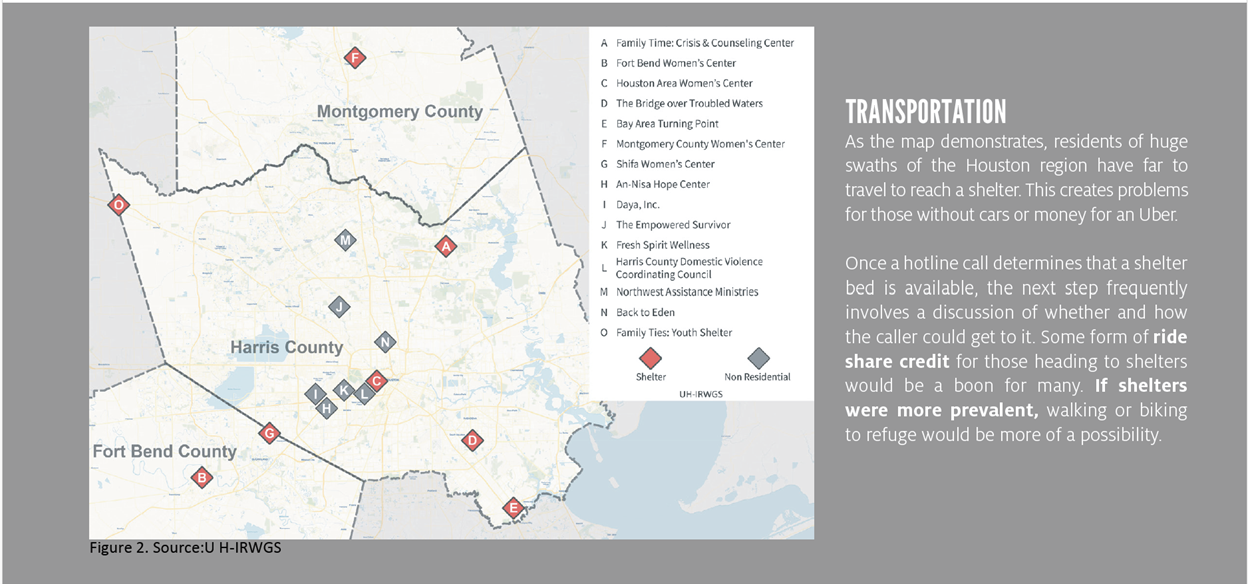A Comprehensive Strategy for Addressing Domestic Violence in Houston: A Call for Collaboration and Investment
REPORT
UH IRWGS DV Providers Study – Report to the Community – February 2023
Abstract
Domestic violence (DV) is a severe problem in the Houston region, with high rates of intimate partner violence (IPV) and other forms of family and gender-based violence. This report presents initial findings from a study conducted by the University of Houston Institute for Research on Women, Gender & Sexuality (UH IRWGS) in collaboration with local DV service providers and highlights the need for a comprehensive and collaborative approach to addressing DV in the region. The study’s findings reveal a significant gap between the demand for DV services and the capacity of existing providers, emphasizing need for increased resources to expand services and support survivors.
Key Findings
- High Prevalence of DV: The Houston region experiences high rates of DV, including an alarming rise in IPV-related homicides (2019 to 2022) and calls for service to police. This underscores the urgent need for interventions to prevent and respond to DV.
- Underfunded Services: DV service providers in the Houston region are severely underfunded, hindering their ability to meet the overwhelming demand for shelter, nonresidential services, affordable housing, and other essential support. This funding shortage limits the capacity of providers to offer timely and comprehensive services to survivors.
- Gaps in Service Provision: There is a significant geographic disparity in the distribution of DV shelters, with large areas of the region lacking accessible options. This disparity creates barriers for survivors seeking refuge from abusive situations.

- Need for Collaboration/Centralization: The fragmented nature of DV service provision in the Houston region leads to inefficiencies and hinders the sharing of resources and best practices among providers. A collaborative approach, where providers work together, including centralization of some services, could optimize resource allocation, improve service coordination, and enhance the overall response to DV.
- An initial infrastructure investment of $1 million per year for five years is recommended.
- Importance of Survivor Input: Engaging survivors in the design and implementation of DV services is crucial for ensuring that services are responsive to their needs.
Recommendations
The report proposes a plan to address DV in the Houston region, focusing on collaboration and investment:
- Establish and Fund a Centralized DV Collaborative: Create a centralized DV collaborative that brings together and provides infrastructure for service providers, advocates, and community stakeholders to coordinate efforts, share resources, and develop a unified response to DV.
- Increase Funding for DV Services: Significantly grow funding for services, including shelter expansion, nonresidential support, legal aid, and counseling, to enable providers to meet demand.
- Expand Shelter Capacity: Prioritize the expansion of shelter capacity, particularly in underserved areas, to ensure that all survivors have access to safe shelter when needed.
- Invest in Data Collection and Analysis: Invest in data gathering to collect accurate information on the prevalence, patterns, and causes of DV in the region. This data will inform evidence-based policy development, allowing for targeted, effective interventions.
- Engage Survivors in Design: Actively engage survivors in the design and implementation of DV services to ensure they are responsive to their needs. This engagement can be facilitated through survivor advisory boards, focus groups, etc.
- Promote Collaboration and Information Sharing: Foster collaboration among DV service providers, law enforcement agencies, and other stakeholders to facilitate information sharing, improve service coordination, and enhance overall response.
- Address Underlying Causes: Develop and implement strategies to address the root causes of DV, such as poverty, gendered wage inequity and other gender inequalities, and systemic oppression. This requires a collaborative effort involving multiple sectors, including business, education, housing, healthcare, and criminal justice.
Conclusion
This report serves as a call to action for a comprehensive and collaborative response to DV in the Houston region. By investing in DV services, promoting collaboration, and addressing the underlying causes of violence, the community can create a safer and more equitable environment for all.